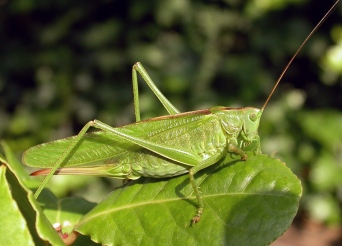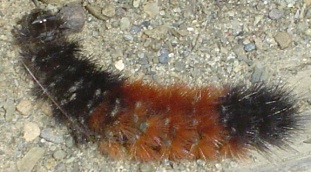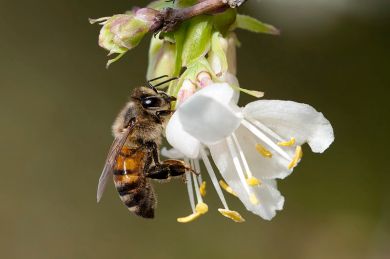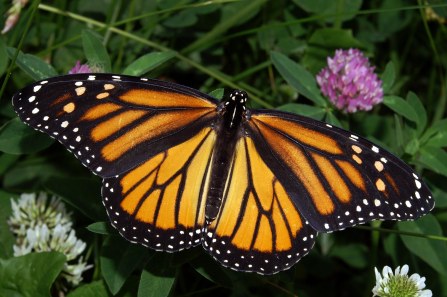Insect adventures

A bush cricket (Tettigonia viridissima), which looks a lot like a large version of the grasshopper on my windshield. An insect this size probably would’ve drawn my attention before I started driving! Image credit: By Fritz Geller-Grimm [CC BY-SA 2.5 (https://creativecommons.org/licenses/by-sa/2.5) or CC BY-SA 2.5 (https://creativecommons.org/licenses/by-sa/2.5)%5D, from Wikimedia Commons
I love experiences like this one, because it’s fun to share wonder about nature with my family. My son and I came up with a whole slew of new observations and questions about grasshoppers on our short drive home. (The grasshopper arrived safely, but I can’t vouch for its future in our yard full of birds.) I am definitely NOT an expert on insects, so I had no idea how a grasshopper holds onto glass. So I did what anyone would do: looked online! A brief article from Scientific American provided an answer for just this question, from Richard Fell, a retired entomologist at Virginia Tech University. Apparently, grasshoppers have little “hairy” pads on their feet that secrete oils. The oils and pads help them stick to the small imperfections in the surface of glass. My grasshopper stowaway apparently had very grippy feet indeed. It was rather amazing to watch!
My search for grasshopper information led me to some interesting insect trivia. For example, did you know grasshoppers may regurgitate a staining liquid colloquially called “tobacco juice,” if you hold them in your hand? I don’t recall ever picking up a grasshopper, so I’ve never experienced this phenomenon. Not much is known about why they do this, but it might be a stress response to potential danger. This information was posted online by the Purdue University Extension program, which helps share information about agriculture, nature, and other areas of science and technology with communities across the state of Indiana. I’ve enjoyed watching children explore Purdue Extension’s boxes of insect collections and live insect ambassadors, in person at local community science events, so I know getting people interested in insects is a big part of what they do. And their website led to one more diversion, an article published just this week: it’s the time of year for spotting woolly worms! Legend has it that these charming caterpillars will predict the winter weather. I have warm and fuzzy memories of finding these critters and holding them gently in my hand, feeling them tickle as they crawled across my arm. I saw a woolly worm just a few weeks ago on a screen on my house. My family and I enjoyed its visit, a clear sign of the impending change of seasons.

A “woolly bear” or “woolly worm” caterpillar of the moth Pyrrharctia isabella. Winter could be on its way… Image credit: By Angela Houck (My house) [Public domain], via Wikimedia Commons
Insects everywhere
Engaging with nature firsthand is one of the best ways to feel connected to the species that surround us. Most people I’ve met, tucked away in homes and cities in the middle of North America, have an aversion to insects and other arthropods, based on personal experience or unfamiliarity. These animals are not warm and fuzzy (woolly worms aside), and many insects are known pests for the agricultural crops that grow in abundance here, or unwelcome intruders in our homes (ants, I’m looking at you). But insects are incredibly diverse, many are downright beautiful (ooh, butterflies), and they play an important part in the life cycles of plants (thanks, pollinators!) and the food chains of birds and other larger animals. Without insects, the world would be a less interesting—and drastically less ecologically balanced—place in which to live.
Insects are all around us, but it’s easy to ignore how truly abundant and diverse they are, and how much we still don’t know about them. The data-loving site FiveThirtyEight tackled insects by the numbers, in response to this question from a four-year-old: “What weighs more: all of the people or all of the bugs?” The figures are staggering: at least 400 million metric tons of the insects consumed by spiders alone per year vs. just shy of 300 million metric tons of humans. And we really have no idea how many species of insects are out there (not to mention other tinier species, such as bacteria). Millions of species remain undiscovered and uncataloged. Our ignorance about insects should be humbling.
Trouble ahead?
And yet. We sometimes fail to notice our own ignorance and get a little carried away with the short-term concerns right before us. Pesticide use for agriculture has helped increase crop production, but we may be thinning out the biodiversity of local insect species that help keep our local ecosystems in balance. Likewise, deforestation of ecologically rich tropical areas for human agriculture and development may cause the loss of countless species of insects (most of which we haven’t even discovered). If the insect populations become unbalanced, so too may go the plants and animals that depend on them.
One way we know this may already be happening? Check your car’s windshield after a trip. In my childhood, a long-distance car trip in the summer meant a windshield and front end covered in sticky, spattered bug guts. Now, not so much. Where have all the messy, everyday insects of summer gone? One study ongoing in Germany is trying to gather some data on these anecdotal concerns in Europe. They’ve noticed a steep (80%) decline in some insect population studies in just a few years. It’s not clear how this trend will play out, but I have been following this story over the past few years, and it’s disconcerting to me. I enjoy the wild birds in my community, and we rely on local pollinators for both agricultural and ornamental plants in my area. Much has been reported about the plight of the honeybee, an important natural and agricultural pollinator that is facing declining populations through a likely combination of disease, pesticides, and habitat loss. Locally, efforts are ongoing to monitor the numbers of pollinators using a citizen-science approach. The more data we have about insect populations, the better we can track changes over time.

A honeybee (Apis mellifera) visitng a honeysuckle flower. We rely on honeybees as pollinators of crops, and their colonies are facing collapse from multiple potential causes. Image credit: By Zeynel Cebeci [CC BY-SA 4.0 (https://creativecommons.org/licenses/by-sa/4.0)%5D, from Wikimedia Commons

A majestic monarch butterfly (Danaus plexippus), a summer visitor to North America. Monarch caterpillars eat the milkweed plant, which itself is declining in abundance throughout North America. Helping maintain monarch populations may depend on people planting more milkweed in breeding areas throughout North America. Image credit: Kenneth Dwain Harrelson [GFDL (http://www.gnu.org/copyleft/fdl.html) or CC BY-SA 3.0 (https://creativecommons.org/licenses/by-sa/3.0)%5D, via Wikimedia Commons
I love finding praying mantises in our garden. They are so creepy yet cool! Other fun experiences this summer: watching ladybugs eat aphids on my milkweed; finding monarch caterpillars on my milkweed and taking them in to work to monitor and watch transform; finding new to me cool bugs on said milkweed; and watching butterflies and dragonflies visit our flowers.
LikeLiked by 1 person
Pingback: Summer’s coneflowers | Mulled Science